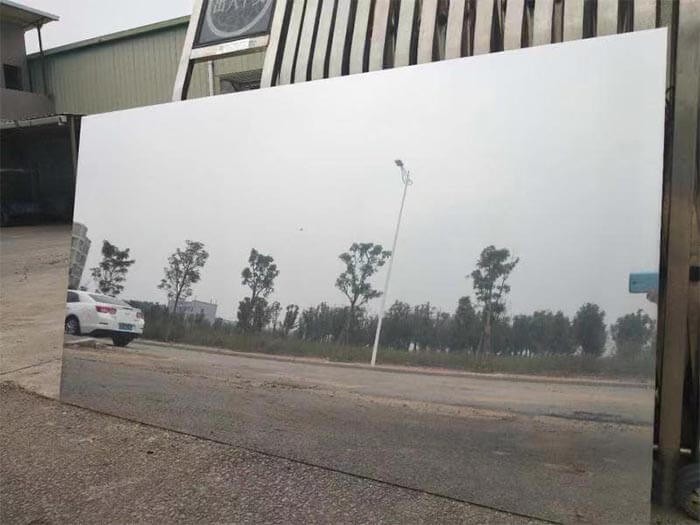PVD Anodized Mirror Aluminium Sheet
Width: Up to 1500mm
Length: Customizable
Reflectivity: Up to 98%
Coating Thickness: 0.5μm – 2.5μm
Introduction to PVD Anodized Mirror aluminium Sheet
PVD (Physical Vapor Deposition) anodized mirror aluminium sheets are premium materials known for their high reflectivity, durability, and aesthetic appeal. These sheets are manufactured using advanced PVD technology, which deposits a thin, protective metallic coating on anodized aluminium. This enhances both the functional and decorative properties, making these sheets a popular choice across various industries.
Technical Specifications
| Specification | Details |
Thickness | 0.2mm – 3.0mm |
Width | Up to 1500mm |
Length | Customizable |
Reflectivity | Up to 98% |
Coating Thickness | 0.5μm – 2.5μm |
Key Features and Properties
| Details | Property |
Reflectivity | Up to 98%, offering a true mirror-like appearance. |
Corrosion Resistance | Exceptional, thanks to the protective anodized and PVD layers. |
Surface Hardness | High, ensuring excellent scratch resistance. |
Color Options | Available in silver, gold, bronze, black, and custom colors. |
Lightweight | aluminium base ensures low weight while maintaining strength. |
Eco-Friendly | Recyclable and produced with sustainable manufacturing techniques. |
Durability | Resistant to wear, weathering, and UV exposure. |
Manufacturing Process
1. Base Material Preparation
High-quality aluminium sheets (typically 1xxx or 3xxx series) are cleaned and pre-treated to ensure a smooth surface.
2. Anodizing
The aluminium undergoes an anodizing process to form a durable oxide layer, enhancing its corrosion resistance and providing a suitable surface for the PVD coating.
3. PVD Coating
A thin metallic film is deposited using PVD technology in a vacuum environment. This step determines the sheet's final color and finish.

4. Polishing and Quality Control
The sheets are polished to achieve a flawless mirror finish and undergo rigorous quality checks.
Applications of PVD Anodized Mirror aluminium Sheets
Architecture and Interiors
Decorative wall panels, ceilings, and cladding.
Mirror panels in elevators and escalators.
Consumer Electronics
Enclosures for laptops, smartphones, and other gadgets.
Lighting and Signage
Reflectors for LED lights and decorative signage.
Automotive
Interior trims, dashboard accents, and emblems.
Furniture and Home Decor
High-end furniture panels, mirror frames, and decorative partitions.
Retail Displays
Luxury store fixtures and promotional displays.

Comparison with Other aluminium Mirror Sheets
| Type | Durability | Durability | Applications | Cost |
PVD Anodized Mirror | Up to 98% | Superior (UV and scratch-resistant) | Premium architectural and automotive uses | $$$$ |
Standard Anodized Mirror | 85-90% | Good | General interior and exterior cladding | $$ |
75-85% | Moderate | Basic reflectors and DIY projects | $ |
Key Differences
PVD Coating: Adds additional durability and a broader range of colors.
Reflectivity: Higher in PVD anodized sheets due to enhanced surface treatment.
Cost: PVD sheets are more expensive due to advanced manufacturing processes.
Advantages of Choosing PVD Anodized Mirror aluminium Sheets
Superior Aesthetic Appeal
The mirror-like finish creates a luxurious appearance, enhancing the visual impact of any project.
Long-Lasting Performance
The combination of anodizing and PVD ensures excellent resistance to environmental factors.
Customization Options
Available in a wide range of thicknesses, finishes, and colors to meet specific project requirements.
How to Select the Right PVD Anodized Mirror aluminium Sheet
Determine Application Needs: Assess the environmental conditions and functional requirements of your project.
Choose the Right Thickness: For architectural applications, opt for thicker sheets for added rigidity.
Consider Color and FinishMatch the sheet's appearance to your design aesthetic.
Evaluate Supplier Credibility: Ensure your supplier offers high-quality materials with necessary certifications.

Maintenance and Care
PVD anodized mirror aluminium sheets require minimal maintenance.
Cleaning: Use a soft cloth and mild detergent to remove dirt and smudges.
Avoid Abrasives: Do not use harsh chemicals or abrasive cleaning tools.
Inspection: Regularly inspect for damage, especially in high-traffic areas.
Why Choose Huawei aluminium?
Expertise: Over 15 years of experience in aluminium processing.
Quality Assurance: ISO-certified production processes.
Global Reach: Serving clients across multiple industries worldwide.
Eco-Friendly Practices: Commitment to sustainable manufacturing.
Send Inquiry





